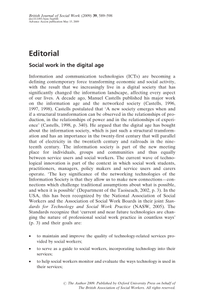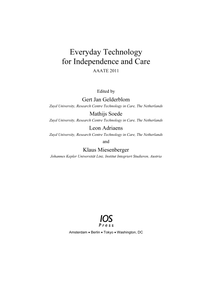The fundamental premise of this chapter is that technology-mediated remote work in and of itself is not necessarily a panacea for disability inclusion. This necessitates a focus on what technologies enables individuals to do (and not do). This chapter draws on a mixed-methods (a survey and qualitative interviews) study of disabled workers in Belgium and the United Kingdom guided by the overarching question of which affordances and constraints are experienced by disabled workers when interacting with remote work technology during the initial two lockdowns of the COVID-19 pandemic.
MULTIFILE
This research report contains the findings of an international study consisting of three online ‘living’ surveys. The surveys focused on how the COVID-19 pandemic has impacted sign language interpreters’ working practices, how this was experienced by them, and how digital disruption caused by the pandemic is impacting and innovating the sign language interpreting profession. The study was carried out between April 2020 and July 2020; the largest contingent of respondents over all three surveys were from the U.S., followed by the UK, the Netherlands, Germany, Finland and Belgium. Respondents commented that the crisis will probably accelerate the need for remote interpreting training in interpreter training programs. Another resurfacing issue was the perceived need for sign language interpreting students to have face-to-face practice and live mentoring. Respondents commented on what benefits they thought remote interpreting might bring to the table, both for themselves and for deaf people. In general, the most significant benefits that were mentioned were flexibility and the possibility to improve efficiency and availability of sign language interpreting services. Notwithstanding these benefits, a significant number of respondents claimed that remote interpreting is more stressful than face-to-face interpreting and requires a heavier cognitive load.
DOCUMENT

The COVID-19 pandemic has forced higher education (HE) to shift to emergency remote teaching (ERT), subsequently influencing academic belonging and social integration, as well as challenging students' engagement with their studies. This study investigated influences on student engagement during ERT, based on student resilience. Serial mediation analyses were used to test the predictive effects between resilience, academic belonging, social integration, and engagement.
MULTIFILE

Inleiding op een themanummer van British Journal of Social Work over sociaal werk in de digitale samenleving.
DOCUMENT

Most people with dementia (PwD) are cared for by unpaid family carers, many of whom must balance caring with paid work. This regularly entails dealing with care-related emergencies (CRE). This study aims to explore the impact of carers’ autonomy at work regarding breaks, schedule, and place on their ability to manage CRE, and use technology to that end. We conducted interviews with 16 working carers of PwD in Scotland. Data were analysed thematically to identify key themes. Autonomy at work appeared on a spectrum from no to complete autonomy. Carers’ position on this spectrum was often dynamic and determined by the nature of their work, their workplace culture and regulations, and their line managers’ support – or clients in the case of self-employed carers. Break autonomy allowed carers to use technology to be notified of and delegate the CRE response. Schedule autonomy allowed for an in-person response to CRE. Place autonomy allowed carers to work and care simultaneously, which enabled them to manage CRE immediately but presented them with additional challenges. Distance between workplace and PwD’s residence impacted carers’ ability to manage CRE, despite having complete autonomy. Implications for healthcare professionals, service providers, employers, policymakers, and technology developers are presented.
DOCUMENT

This article examines the impact of the COVID-19 pandemic on the sign language interpreting profession drawing on data from a fourth and final survey conducted in June 2021 as part of a series of online “living surveys” during the pandemic. The survey, featuring 331 respondents, highlights significant changes in the occupational conditions and practices of sign language interpreters due to the sudden shift towards remote video-mediated interpreting. The findings reveal a range of challenges faced by interpreters, including the complexities of audience design, lack of backchanneling from deaf consumers, the need for heightened self-monitoring, nuanced conversation management, and team work. Moreover, the study highlights the physical and mental health concerns that have emerged among interpreters as a result of the shift in working conditions, and a need for interpreters to acquire new skills such as coping with the multimodal nature of online interpreting. While the blend of remote, hybrid, and on-site work has introduced certain advantages, it also poses new challenges encompassing workload management, online etiquette, and occupational health concerns. The survey’s findings underscore the resilience and adaptability of SLIs in navigating the shift to remote interpreting, suggesting a lasting transformation in the profession with implications for future practice, training, and research in the post-pandemic era.
DOCUMENT

Internet on the Outstation provides a new take on the digital divide. Why do whole communities choose to go without the internet when the infrastructure for access is in place? Through an in-depth exploration of the digital practices occurring in Aboriginal households in remote central Australia, the authors address both the dynamics of internet adoption and the benefits that flow from its use. The book challenges us to think beyond the standard explanations for the digital divide, arguing that digital exclusion is not just another symptom of social exclusion. At its heart, Internet on the Outstation is a compelling examination of equality and difference in the digital age, asking: Can internet access help resolve the disadvantages associated with remote living?Internet on the Outstation is the result of a multi-year research collaboration, which included a trial of internet infrastructure, training and maintenance in three small Aboriginal communities (known as outstations). During the research phase, Ellie Rennie, Eleanor Hogan and Julian Thomas were based at the Swinburne Institute for Social Research in Melbourne. Robin Gregory and Andrew Crouch worked at the Centre for Appropriate Technology, an Indigenous-owned research and training organization in Alice Springs. Alyson Wright worked for the Central Land Council, the representative body for traditional owners of the central Australia region.
MULTIFILE

Transitions in health care and the increasing pace at which technological innovations emerge, have led to new professional approach at the crossroads of health care and technology. In order to adequately deal with these transition processes and challenges before future professionals access the labour market, Fontys University of Applied Sciences is in a transition to combining education with interdisciplinary practice-based research. Fontys UAS is launching a new centre of expertise in Health Care and Technology, which is a new approach compared to existing educational structures. The new centre is presented as an example of how new initiatives in the field of education and research at the intersection of care and technology can be shaped.
DOCUMENT

The 'implementation' and use of smart home technology to lengthen independent living of non-instutionalized elderly have not always been flawless. The purpose of this study is to show that problems with smart home technology can be partially ascribed to differences in perception of the stakeholders involved. The perceptual worlds of caregivers, care receivers, and designers vary due to differences in background and experiences. To decrease the perceptual differences between the stakeholders, we propose an analysis of the expected and experienced effects of smart home technology for each group. For designers the effects will involve effective goals, caregivers are mainly interested in effects on workload and quality of care, while care receivers are influenced by usability effects. Making each stakeholder aware of the experienced and expected effects of the other stakeholders may broaden their perspectives and may lead to more successful implementations of smart home technology, and technology in general.
DOCUMENT

Technological advancements and sophisticated information and technological systems are being increasingly used by organizations which affect our daily lives to a large extent. Covid-19 pandemic has fast-forwarded the transition towards a virtual workforce and remote working. Higher Education Institutions (HEIs) are not an exemption and still after the world has come to put an end on the pandemic there are yet uncertainties about the extent to which educational systems will use online or hybrid working systems and how this phenomenon can affect motivation of academics. The study uses a phenomenological approach, and it is comparative in nature where the motivation and experience of university faculty members and researchers from different generations in Germany and the Netherlands. A total number of 23 interviews were conducted with academics in the mentioned countries. Findings reveal that there are some similarities and differences amongst different generations regarding the impact of remote working on employee’s motivation. This study provides crucial information for policymakers in the higher education sector to rethink and reformulate HR policies in a manner that can enhance employees’ motivation when working remotely, considering the needs and expectations of different generations.
DOCUMENT